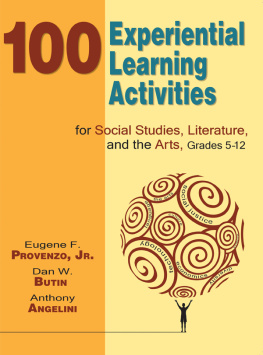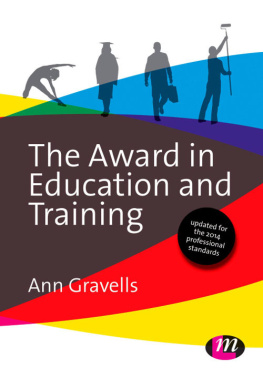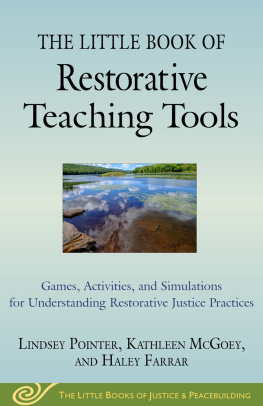Experiential
Learning
THIRD EDITION |

| Experiential
Learning
A handbook for
education, training
and coaching |
Colin Beard
John P Wilson |

|
Publishers note
Every possible effort has been made to ensure that the information contained in this book is accurate at the time of going to press, and the publishers and authors cannot accept responsibility for any errors or omissions, however caused. No responsibility for loss or damage occasioned to any person acting, or refraining from action, as a result of the material in this publication can be accepted by the editor, the publisher or any of the authors.
First published in Great Britain and the United States in 2002 by Kogan Page Limited entitled
The Power of Experiential Learning
Second edition 2006 entitled Experiential Learning
Third edition 2013
Apart from any fair dealing for the purposes of research or private study, or criticism or review, as permitted under the Copyright, Designs and Patents Act 1988, this publication may only be reproduced, stored or transmitted, in any form or by any means, with the prior permission in writing of the publishers, or in the case of reprographic reproduction in accordance with the terms and licences issued by the CLA. Enquiries concerning reproduction outside these terms should be sent to the publishers at the undermentioned addresses:
120 Pentonville Road | 1518 Walnut Street, Suite 1100 | 4737/23 Ansari Road |
London N1 9JN | Philadelphia PA 19102 | Daryaganj |
United Kingdom | USA | New Delhi 110002 |
India |
www.koganpage.com
Colin Beard and John P Wilson
The right of Colin Beard and John P Wilson to be identified as the authors of this work has been asserted by them in accordance with the Copyright, Designs and Patents Act 1988.
ISBN 978 0 7494 6765 4
E-ISBN 978 0 7494 6666 1
British Library Cataloguing-in-Publication Data
A CIP record for this book is available from the British Library.
Library of Congress Cataloging-in-Publication Data
Beard, Colin (Colin M.)
Experiential learning : a handbook for education, training and coaching / Colin Beard, John P. Wilson. Third edition.
pages cm
Includes bibliographical references and index.
ISBN 978-0-7494-6765-4 ISBN 978-0-7494-6766-1 1. Experiential learningHandbooks, manuals, etc. 2. Active learningHandbooks, manuals, etc. 3. EmployeesTraining ofHandbooks, manuals, etc. I. Wilson, John P. (John Peter), 1955 Aug. 11-II. Title.
BF318.5.B43 2013
153.152dc23
2013011418
Typeset by AMNET
Printed and bound in India by Replika Press Pvt Ltd
CONTENTS
04 Learning environments: spaces and places
(The belonging dimension)
05 Experiential learning activities
(The doing dimension)
06 Sensory experience and sensory intelligence (SI)
(The sensing dimension)
07 Experience and emotions
(The feeling dimension)
08 Experience, knowing and intelligence
(The knowing dimension)
09 Experience, learning and change
(The being dimension)
PART ONE
Experiential
learning:
foundations
and
fundamentals
Experience is the child of Thought, and Thought is the child of Action we cannot learn men from books .
BENJAMIN DISRAELI, 1826
If you followed the advice of Benjamin Disraelis quotation above, you would not proceed any further than the first page of this book before returning it to the shelf! However, dont go away; bear with us as we explain how this book will offer a new way of thinking about and organizing the development and delivery of experiential learning.
Disraeli was using his skills as a political orator to polarize the debate about theory and practice and draw attention to the need to think and learn through experience. The argument that we cannot learn men through books is an unsustainable one but Disraelis underlying message has a kernel of truth. Traditional learning, with the teacher or trainer spouting facts and figures and with pupils or participants regurgitating the information without deeper involvement, is a very ineffective form of learning. A much more effective and long-lasting form of learning is to involve the learner by creating a meaningful learning experience.
This handbook will enable you to see new opportunities to unleash some of the more potent opportunities for learning through experience. In order to free the spirit of learning, whether it be in management education, corporate training, youth development work, therapy, higher education or life coaching, it is necessary to explore in much greater detail the interconnected nature of the learning experience. We explore the meaning of experiential learning in including biology, neurophysiology, psychology, and social and environmental sciences. Experiential learning was defined in our second-edition book as a sense-making process of active engagement between the inner world of the person and the outer world of the environment. Here we introduce a balanced, connective approach to learning as:
a sense making process involving significant experiences that, to varying degrees, act as the source of learning. These experiences actively immerse and reflectively engage the inner world of the learner, as a whole person (including physical-bodily, intellectually, emotionally and spiritually) with their intricate outer world of the learning environment (including belonging and doing in places, spaces, within social, cultural, political context etc) to create memorable, rich and effective experiences for and of learning.
(Beard, 2010: 17)
This is of course a very broad and rudimentary definition. Edward Cell in his book Learning to Learn from Experience , referred to a definition offered by Keeton and Tate way back in 1978. Cell was highlighting the differences between academic learning and experiential learning, and the definition quoted referred to experiential learning as:
learning in which the learner is directly in touch with the realities being studied. It is contrasted with learning in which the learner only reads about, hears about, talks about, or writes about these realities but never comes into contact with them as part of the learning process.
(Keeton and Tate, 1978, in Cell, 1984: viii).
Interestingly, the Keeton and Tate text was titled Learning by Experience what, why and how . The immersion in, and contact with, the experience is thus perceived as very important. The experience takes centre stage: it is the foundation of, and the stimulus for, learning. This is the core argument in much theoretical work on experiential learning. That is why several core dimensions of the experience of learning form the focus of this book.
Although there are no easy answers to the creation of learning experiences, whether they be by deliberate programme design or by emergent opportunity, there are significant areas of knowledge about many of the main ingredients that can be used to create new and innovative learning experiences. In this first chapter we illustrate this with a model, presented initially and for practical understanding in the form of a combination lock, which comprises a series of tumblers each designed to illustrate the almost infinite range of ingredients that can be altered in order to enhance learning. Many participants on our programmes are given six polystyrene cups that fit together and rotate to form a copy of the combination lock model. Using this visual metaphor of a combination lock with six tumblers, the potential number of learning permutations is more than 15 million and it can be further expanded to an almost infinite number. Although we are on our guard to avoid simplistic mechanistic thinking, we do believe it is robust material and we discuss the theoretical basis of our thinking, as well as offering many practical examples to illustrate the value of learning from experience. Learning specialists are required to understand the very complex processes involved in experiential learning, and that is where this model can help unpick some of the complexity. We have also used other visual interpretations of the model to aid initial understanding and memory retention: a tennis court in Malaysia, where the net represented the senses, large pebbles on a beach in Greece, and a large yellow circle that was found painted on concrete flooring on Pulau Ubin off the coast of Singapore where Outward Bound is based. The yellow circle was used as the sensory interface between the inner and outer worlds and we added coloured plastic hoops to facilitate discussion of other key dimensions involved in experiential learning.
Next page








